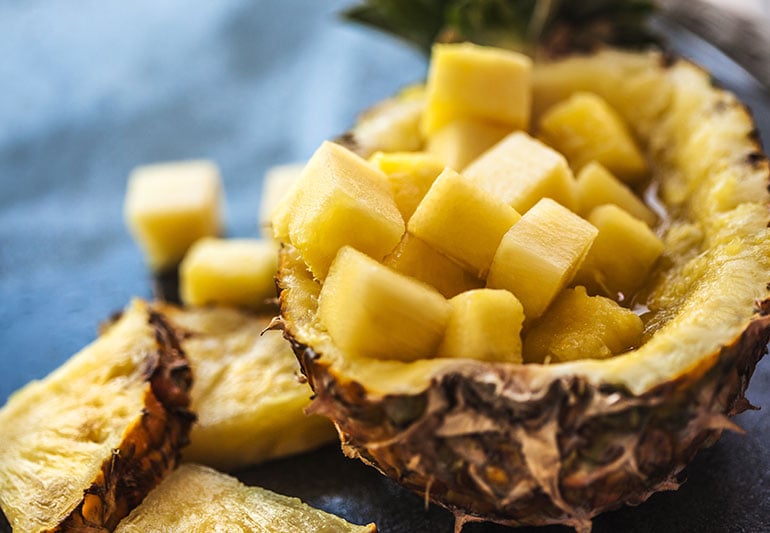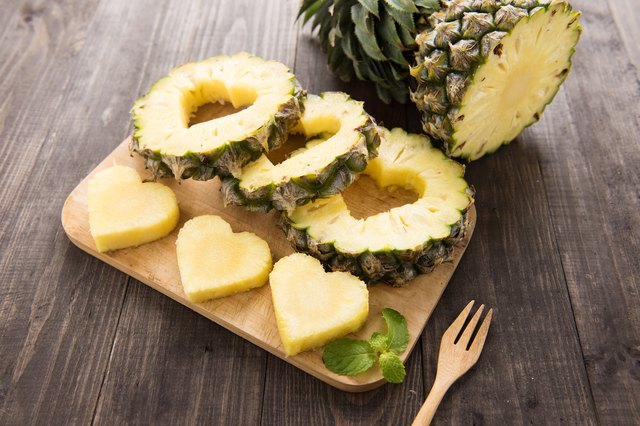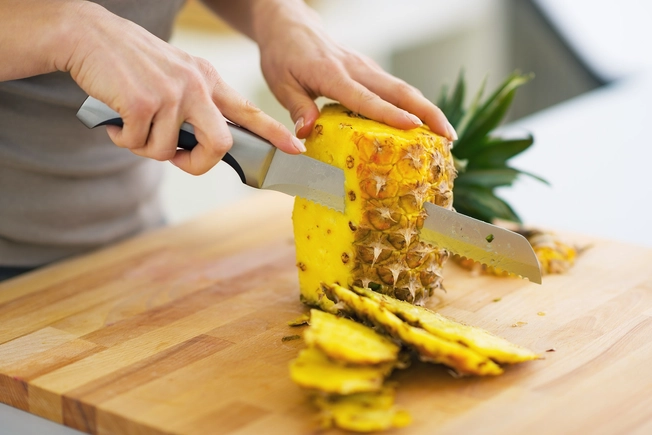The health benefits of pineapple

Pineapple (Ananas comosus) is a tropical fruit known for its iconic shape – a sphere of sweet and juicy flesh surrounded by a tough, segmented skin, with a tuft of spiky green leaves on top. The fruit is actually a collection of flowers, each with its own eye which is fused around the central core, which takes a staggering three years to mature.

Nutritional benefits of pineapple
- 33Kcal / 141KJ
- 0.3g Protein
- 0.2g Fat
- 8.1g Carbohydrate
- 1.3g Fibre
- 128mg Potassium
- 10mg Vitamin C
May aid digestion
Being a rich source of fibre, fruit like pineapple may help support a healthy digestive system. Furthermore, the enzymes in pineapple, known as bromelain breaks down proteins into their smaller building blocks of amino acids and peptides, and is active in both the acid environment of the stomach and the alkaline conditions of the small intestine. This makes it an extremely useful digestive aid for those who don’t digest their food properly, especially for those with pancreatic insufficiency, a condition in which the pancreas fails to produce enough digestive enzymes.
Although research into the anti-inflammatory effect of bromelain on alleviating the symptoms of inflammatory bowel conditions, such as ulcerative colitis looks promising, more evidence is needed before this benefit can be proven in humans.
Promote healing after injury

A number of studies suggest that bromelain helps reduce inflammation, swelling and bruising after injury or surgery. It can even be useful if taken before dental surgery, when it appears to help reduce pain and provide as much relief as anti-inflammatory medication.
In vitro research (conducted in a test tube) has also demonstrated bromelain’s value in wound healing.
Help relieve the symptoms of arthritis
Numerous studies, dating back as far as the 1960s have demonstrated how useful bromelain can be in the relief of the inflammatory pain associated with arthritis. It appears to have this analgesic action through a direct influence on the chemical mediators that are involved in our perception of pain.
Support immunity

A nine-week study of school children who ate either a moderate amount of canned pineapple (140g) or a large amount (280g) every day, had a significantly lower risk of catching a viral or bacterial infection than those who ate none. In addition to this, those who ate the higher amount had four times the number of infection-fighting white immune cells.
The anti-inflammatory properties of bromelain also appear to be valuable in helping modulate the immune system, and may be especially valid for those with auto-immune conditions.
Support the cardiovascular system

Once again, it is bromelain that appears to have value to the heart and circulatory system through its action on preventing or minimising the severity of attacks of angina and transient ischaemic attack (TIA). It’s also thought that bromelain may break down the cholesterol plaques, responsible for hardening of the arteries which may lead to a condition called atherosclerosis.
Animal studies suggest bromelain also influences blood clotting by inhibiting the production of a protein called fibrin which is involved in blood coagulation.
Post-Workout Recovery
Intense workout? The anti-inflammatory benefits of the bromelain in pineapple can help muscles recover quicker and keep you from feeling sore.
How to Select a Pineapple
Smell the end of the pineapple first. Does it smell like pineapple? Good. Does it smell fermented? Keep looking. It should feel heavy and not have any soft spots or bruises.

How to Store Fresh Pineapple
A ripe, whole pineapple will keep on the counter for 2-3 days. Once you cut it, it’ll stay good in the fridge for 5-7 days, or in the freezer for 6 months or more. You can store it on its own or in its juice.

How to Cut Fresh Pineapple
They may be the world’s friendliest fruit, but pineapples can be confusing to cut. Here’s how to get from the rough skin to the juicy fruit: Cut off the top, also called the crown, and the bottom. Dig out any “eyes” left behind. Stand it up and slice off the outer skin from top to bottom. Cut it in half from top to bottom, and then cut those halves into quarters. Slice off the core from all four pieces, then cut into smaller chunks.







